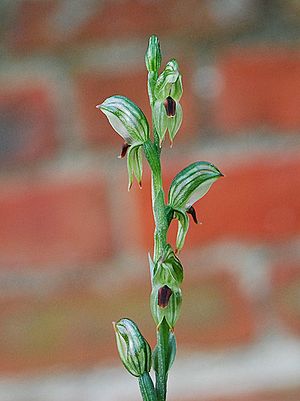Brown-lip leafy greenhood facts for kids
Quick facts for kids Brown-lip leafy greenhood |
|
|---|---|
 |
|
| Pterostylis williamsonii growing in Royal Tasmanian Botanical Gardens | |
| Scientific classification | |
| Genus: |
Pterostylis
|
| Species: |
williamsonii
|
| Synonyms | |
|
|
The brown-lip leafy greenhood (scientific name: Pterostylis williamsonii) is a special type of orchid plant. It's found only in Tasmania, an island state of Australia. When it flowers, it has beautiful transparent green flowers with darker green and brown stripes. These flowers have a fuzzy, insect-like part called a labellum with a dark stripe.
If the plant isn't flowering, it has a group of leaves shaped like a circle, called a rosette. But when it's ready to flower, these rosette leaves disappear. Instead, the flowering plant grows five to seven leaves along its stem.
What it Looks Like
The brown-lip leafy greenhood is a terrestrial plant, meaning it grows in the ground. It's a perennial plant, which means it lives for more than two years. It's also deciduous, so some parts die back each year, but it grows back from an underground tuber (like a small potato).
Leaves and Stems
Non-flowering plants have a rosette of four to six dark green, egg-shaped leaves. These leaves are on a short stalk, about 10–30 mm (0.4–1 in) long. Each leaf is about 3–35 mm (0.1–1 in) long and 3–8 mm (0.1–0.3 in) wide.
Flowering plants grow a stem that can be 90–300 mm (4–10 in) tall. This stem has five or six lance-shaped leaves, which are about 40–70 mm (2–3 in) long and 4–7 mm (0.2–0.3 in) wide.
Flowers
The flowers are transparent green with darker green and brown stripes. They are about 13–17 mm (0.5–0.7 in) long and 6–8 mm (0.2–0.3 in) wide.
The top part of the flower forms a hood, like a helmet, over the central part (called the column). This hood is made from a fused sepal (a leaf-like part that protects the flower bud) and petals. The tip of this hood is often brown.
The two side sepals point downwards. They are about 12–15 mm (0.5–0.6 in) long and 6–8 mm (0.2–0.3 in) wide. They have a narrow tip about 4 mm (0.2 in) long, which is orange-brown.
The most interesting part is the labellum. This is a special lip-like petal that often looks like an insect. For this orchid, the labellum is about 4–5 mm (0.16–0.20 in) long and 3 mm (0.1 in) wide. It can be creamy yellow to dark chocolate brown and has a black stripe down the middle.
This orchid usually flowers from April to July.
How it Got its Name
The brown-lip leafy greenhood was officially described in 1998 by a botanist named David Jones. He published its description in a scientific book called Australian Orchid Research.
The plant's scientific name, williamsonii, was chosen to honor Ronald Herbert Williamson (1931-2003). He was the person who collected the very first plant specimen that scientists used to describe this new species. This first collected plant is called the type specimen.
Where it Lives
This orchid is common across Tasmania. You can find it growing in forests, often among low shrubs and bracken ferns.

